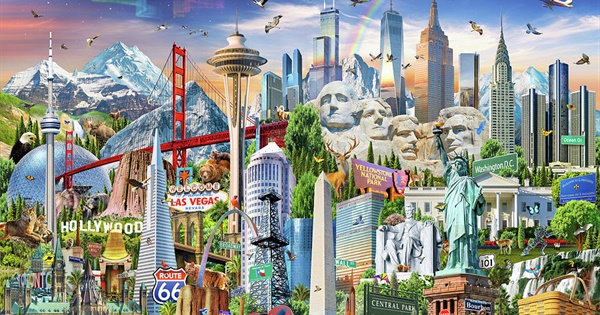North America is a mosaic of breathtaking landscapes, diverse cultures, and iconic attractions that beckon travelers from all corners of the globe. From the vast national parks that showcase nature’s grandeur to vibrant urban centers adorned with historical significance, the continent offers a plethora of tourist attractions that can satisfy even the most discerning travelers. As you embark on this journey of exploration, consider: how do we balance the allure of these attractions with the pressing need for environmental stewardship?
The grandeur of the Grand Canyon stands as one of North America’s most remarkable natural wonders, etched by the relentless flow of the Colorado River over millions of years. This vast geological marvel measures 277 miles in length and exposes nearly two billion years of Earth’s geological history. Visitors often find themselves in awe as they gaze upon its expansive vistas. However, the popularity of the Grand Canyon raises concerns regarding sustainable tourism practices. With the sheer volume of visitors each year, how can we preserve its delicate ecosystems while still accommodating those who wish to experience its magnificence?
Moving to the eastern United States, the historical significance of landmarks such as the Statue of Liberty and Independence Hall cannot be overstated. These sites represent the values of freedom and democracy, drawing millions each year. Yet, with significant foot traffic comes the responsibility to ensure that such monuments are not merely preserved, but actively maintained. This brings forth the challenge: Can we cultivate a tourism industry that respects the historical importance of these sites while minimizing carbon footprints? By engaging in eco-friendly travel practices and supporting local conservation efforts, visitors can contribute to the preservation of such iconic landmarks.
Further north, the scenic beauty of Banff National Park in Canada reveals a different side of North America. Nestled in the Canadian Rockies, this national park is endowed with stunning mountain landscapes, glacial lakes, and a rich array of wildlife. However, the increasing popularity of recreational activities—such as hiking and skiing—raises concerns about environmental impact. As adventurers flock to the park, can we incentivize eco-conscious choices? Perhaps visitors could be encouraged to participate in local cleanup initiatives or support sustainable lodging options to mitigate their impact on this pristine environment.
In the realm of urban attractions, cities such as New York, San Francisco, and Toronto exhibit a unique blend of culture, innovation, and history. Times Square, with its dazzling lights and bustling atmosphere, attracts millions annually. But how does one navigate the tensions between urban development and environmental responsibility? The challenge could be framed as a call to action: How can cities transform into models of sustainable urban living? Initiatives such as promoting public transport, enhancing green spaces, and implementing energy-efficient infrastructure are steps in the right direction.
Mounting evidence supports the notion that engaging with natural environments can significantly enhance mental well-being. This is particularly pertinent when we consider eco-tourism as a sector ripe for growth. Destinations like the Galápagos Islands and Costa Rica have set precedents with sustainable practices. Could North America follow suit? By leveraging existing attractions—like the wetlands of the Everglades or the Alaska wilderness—tourism can drive conservation efforts while simultaneously enriching the visitor experience. The question arises, can we prioritize eco-friendly applications within the tourism sector?
Perhaps the juxtaposition of passion for exploration and the urgency of climate change poses a larger philosophical dilemma—how can we advocate for the awe-inspiring beauty of North America while promoting responsible environmental stewardship? The multifaceted answer lies in education: not just for travelers, but for local communities and businesses as well. Embracing sustainable practices, raising awareness around conservation, and encouraging visitors to appreciate instead of exploit these wonders are key steps moving forward.
Moreover, engaging with indigenous communities can provide invaluable insights into sustainable practices that honor the land and its history. The wisdom of those who have lived in harmony with nature offers lessons that modern tourism often overlooks. Recognizing the significance of cultural heritage not only enriches the visitor’s experience but also fosters a sense of responsibility. Therefore, the challenge remains: how can we promote inclusive practices that respect and integrate indigenous knowledge within the tourism framework across North America?
As the tourism landscape evolves, the imperative of sustainable development becomes increasingly salient. Striking a balance between exploration—be it through hiking, sightseeing, or engaging with local culture—and the preservation of North America’s environmental and cultural integrity is essential. Tourists can play a pivotal role by ensuring their experiences are not just memorable but also mindful of the impact they leave behind. Questions arise regarding the feasibility of such an endeavor, but with collaborative effort, innovative solutions could soon redefine travel as we know it.
To encapsulate this discussion, North America is host to a myriad of attractions that captivate the imagination and spur curiosity. However, as stewards of the planet, we must remain keenly aware of the responsibility that accompanies our wanderlust. So, as you embark on your next adventure, ponder this: How will you contribute to a legacy of conservation while immersing yourself in the breathtaking splendor of this diverse continent? The challenge lies in your hands.
